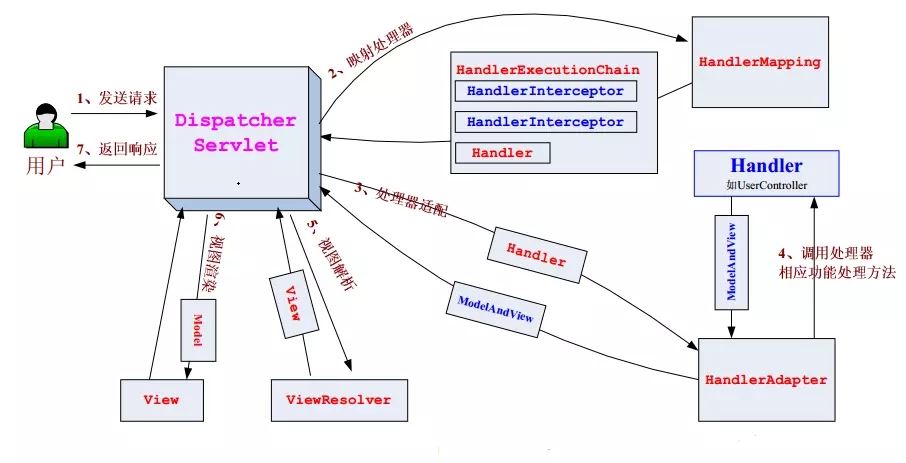书单推荐:成为Java顶级程序员架构师 ,这20来本(高薪)必看点击获取
在分析spring mvc源码之前,先看一张图:

请求处理的过程:
1.DispatcherServelt作为前端控制器,拦截request对象。
2.DispatcherServlet接收到request对象之后,查询HandlerMapping,得到一个HandlerExecutionChain对象。
3.DispatcherServlet将Handler对象交由HandlerAdapter(适配器模式的典型应用),调用相应的controller方法。
4.Controller方法返回ModelAndView对象,DispatcherServlet将view交由ViewResolver进行解析,得到相应的视图。用model渲染视图。
5.返回响应结果。
整个过程的流程其实就是DispatcherServelt中doDispatch()方法的调用过程。
protected void doDispatch(HttpServletRequest request, HttpServletResponse response) throws Exception {
//第一步拦截request对象,doDispatch()方法在doService()方法中被调用,request对象是经过处理的。
HttpServletRequest processedRequest = request;
HandlerExecutionChain mappedHandler = null;
boolean multipartRequestParsed = false;
WebAsyncManager asyncManager = WebAsyncUtils.getAsyncManager(request);
try {
ModelAndView mv = null;
Exception dispatchException = null;
try {
//和文件的上传和下载有关系,判断请求的类型是否是multipart类型
processedRequest = checkMultipart(request);
multipartRequestParsed = (processedRequest != request);
// Determine handler for the current request.
//主要看这里,这里是得到HandlerExecutionChain的方法。关于Handler()方法向下看
mappedHandler = getHandler(processedRequest);
if (mappedHandler == null || mappedHandler.getHandler() == null) {
noHandlerFound(processedRequest, response);
return;
}
// Determine handler adapter for the current request.
//这里已经获取到HandlerExecutionChain对象,接下来就要获取HandlerAdapter对象,调用Handler对象的方法。
HandlerAdapter ha = getHandlerAdapter(mappedHandler.getHandler());
// Process last-modified header, if supported by the handler
//有关浏览器缓存的设定(304)
String method = request.getMethod();
boolean isGet = "GET".equals(method);
if (isGet || "HEAD".equals(method)) {
long lastModified = ha.getLastModified(request, mappedHandler.getHandler());
if (logger.isDebugEnabled()) {
logger.debug("Last-Modified value for [" + getRequestUri(request) + "] is: " + lastModified);
}
if (new ServletWebRequest(request, response).checkNotModified(lastModified) && isGet) {
return;
}
}
//pan'du
if (!mappedHandler.applyPreHandle(processedRequest, response)) {
return;
}
// Actually invoke the handler.
mv = ha.handle(processedRequest, response, mappedHandler.getHandler());
if (asyncManager.isConcurrentHandlingStarted()) {
return;
}
//解析视图,数据渲染
applyDefaultViewName(request, mv);
mappedHandler.applyPostHandle(processedRequest, response, mv);
}
catch (Exception ex) {
dispatchException = ex;
}
processDispatchResult(processedRequest, response, mappedHandler, mv, dispatchException);
}
catch (Exception ex) {
triggerAfterCompletion(processedRequest, response, mappedHandler, ex);
}
catch (Error err) {
triggerAfterCompletionWithError(processedRequest, response, mappedHandler, err);
}
finally {
if (asyncManager.isConcurrentHandlingStarted()) {
// Instead of postHandle and afterCompletion
if (mappedHandler != null) {
mappedHandler.applyAfterConcurrentHandlingStarted(processedRequest, response);
}
}
else {
// Clean up any resources used by a multipart request.
if (multipartRequestParsed) {
cleanupMultipart(processedRequest);
}
}
}
}
protected HandlerExecutionChain getHandler(HttpServletRequest request) throws Exception {
//遍历HandlerMappingList对象(存储若干个HandlerMapping对象),不断调用,直到不为空为止,否则返回null
for (HandlerMapping hm : this.handlerMappings) {
if (logger.isTraceEnabled()) {
logger.trace(
"Testing handler map [" + hm + "] in DispatcherServlet with name '" + getServletName() + "'");
}
HandlerExecutionChain handler = hm.getHandler(request);
if (handler != null) {
return handler;
}
}
return null;
}
以上就是本文的全部内容,希望对大家的学习有所帮助,也希望大家多多支持谷谷点程序。
转载请注明:谷谷点程序 » 从源码角度看spring mvc的请求处理过程
